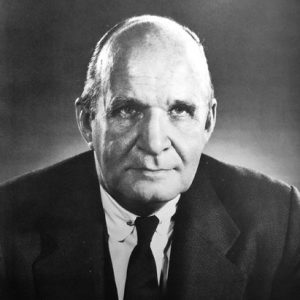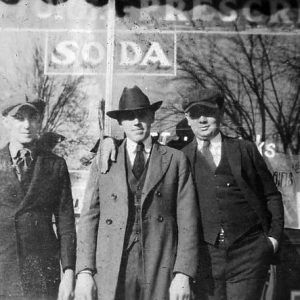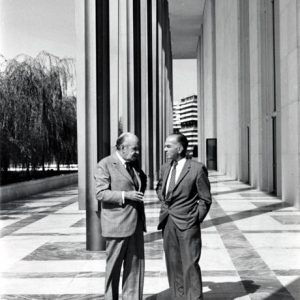calsfoundation@cals.org
Edward Durell Stone (1902–1978)
Edward Durell Stone, one of the foremost American architects of the mid-twentieth century, established an international reputation and designed buildings throughout the world. Though he lived in New York City for much of his adult life, Stone made a lasting contribution to the architecture of his native Arkansas.
Edward Stone was born on March 9, 1902, in Fayetteville (Washington County) to Benjamin Hicks Stone, a merchant and businessman, and Ruth Johnson Stone, a former English teacher at the University of Arkansas (UA) in Fayetteville. The youngest of three children, Stone attended Fayetteville’s public schools but was not a serious student. His mother encouraged his talents for drawing and building things and allowed him to have a home carpentry shop. At age fourteen, he won first prize in a countywide birdhouse competition, the judges of which included an architect and the president of UA.
Stone entered UA in 1920 but moved to Boston, Massachusetts, where his brother was an architect, in 1922. While studying at the Boston Architectural Club, Stone met Henry R. Shepley, one of Boston’s leading architects. Shepley hired him as a draftsman and became his mentor. He attended Harvard Architectural School (1925–1926) on scholarship, followed by and the Massachusetts Institute of Technology (1926–1927), but did not earn a degree. After winning the Rotch Travelling Fellowship in 1927, he spent two years in Europe.
Stone returned to the United States in 1929 and settled in New York City. He married Orlean Vandiver in 1931, and they had two sons. Inspired by the modernist buildings he had seen in Europe, Stone became a proponent of International Style architecture. His early works include the Mandel and Kowalski houses in Mount Kisco, New York; the Mepkin plantation in Moncks Corner, South Carolina; the Museum of Modern Art in New York City, designed in association with Philip Goodwin; and the Goodyear house in Old Westbury, New York. During World War II, Stone served as chief of the planning and design section of the U.S. Army Air Forces.
After the war, he returned to Arkansas to design the Fine Arts Center at UA, the University of Arkansas for Medical Sciences (UAMS) Medical Center in Little Rock (Pulaski County), the Sigma Nu Fraternity house in Fayetteville, and several private residences. At the request of his childhood friend Senator J. William Fulbright, he designed a line of furniture that was manufactured by Fulbright Industries of Fayetteville in the early 1950s.
Stone served as visiting critic at the state’s first school of architecture, which opened in 1947 at UA as part of the College of Engineering. He helped the school obtain accreditation and employed many of its students in his New York office. Fay Jones, a member of the school’s first graduating class, credited Stone’s friendship for showing him what an architect from Arkansas could accomplish in the wider world.
Stone’s first marriage ended in divorce. In 1954, he wed Maria Elena Torchio, and they had a son and a daughter. Stone’s architecture underwent a change in the mid-1950s. The austerity of the International Style was supplanted by the ornate formality exemplified by his design of the U.S. Embassy in New Delhi, India. The embassy’s admirers included Frank Lloyd Wright, who called it “the only embassy that does credit to the United States.” For the remainder of his career, Stone designed buildings that embodied universal and timeless values rather than the “transient enthusiasms” of modernism. He was recognized as a founder of an architectural style that came to be known as New Formalism.
Stone’s principal works include El Panama Hotel in Panama City, Panama; Stanford University Medical Center in Palo Alto, California; the Stuart Pharmaceutical plant in Pasadena, California; the U.S. Pavilion at the World’s Fair in Brussels, Belgium; the National Geographic Society headquarters in Washington DC; the State University of New York at Albany, New York; the Museo de Arte in Ponce, Puerto Rico; the John F. Kennedy Center for the Performing Arts in Washington DC; the General Motors building in New York City; and the National Assembly and Presidential Palace in Islamabad, Pakistan. Several of his buildings won awards from the American Institute of Architects and other organizations. One of his few residential designs was that of the Jay Lewis House, built in McGehee (Desha County) in 1955.
Stone’s second marriage also ended in divorce. He married Violet Campbell Moffat in 1972, and they had a daughter. Stone retired from active practice in 1974. The next year, he donated his professional papers and drawings to UA.
Stone died on August 6, 1978, in New York City after a brief illness. His ashes were interred in Fayetteville’s Evergreen Cemetery, beside the graves of his parents and his brother.
Stone’s early buildings are important examples of modern architecture, but controversy surrounds his later works. Some critics viewed Stone as a “conveyor of banality,” while others praised him for breaking from the mainstream and seeking to restore a sense of history to architecture.
For additional information:
Everett, Derek R. “Modern Statehouses for Modern States: Edward Durell Stone’s Capitol Architecture in North Carolina and Florida.” Southern Historian 28 (Spring 2007): 74–91.
Heyer, Paul, ed. Architects on Architecture: New Directions in America. New York: Walker and Company, 1966.
Hunting, Mary Anne. Edward Durrell Stone: Modernism’s Populist Architect. New York: W. W. Norton & Company, 2013.
———. “Edward Durell Stone: Perception and Criticism.” PhD diss., City University of New York, 2007.
———. “From Craft to Industry: Furniture Designed by Edward Durell Stone for Senator Fulbright.” The Magazine Antiques (May 2004): 110–121.
Stone, Edward Durell. The Evolution of an Architect. New York: Horizon Press, 1962.
Stone, Hicks. Edward Durrell Stone: A Son’s Untold Story of a Legendary Architect. New York: Rizzoli, 2011.
Robert L. Skolmen
Palo Alto City Library
 Arts, Culture, and Entertainment
Arts, Culture, and Entertainment World War II through the Faubus Era, 1941 through 1967
World War II through the Faubus Era, 1941 through 1967 Edward Stone
Edward Stone  Edward Stone
Edward Stone  Edward D. Stone and Student
Edward D. Stone and Student  Edward Stone and J. William Fulbright
Edward Stone and J. William Fulbright 



Comments
No comments on this entry yet.